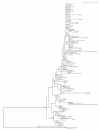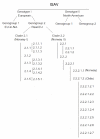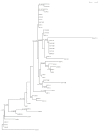Infectious salmon anaemia virus (ISAV) isolated from the ISA disease outbreaks in Chile diverged from ISAV isolates from Norway around 1996 and was disseminated around 2005, based on surface glycoprotein gene sequences
- PMID: 19558648
- PMCID: PMC2710322
- DOI: 10.1186/1743-422X-6-88
Infectious salmon anaemia virus (ISAV) isolated from the ISA disease outbreaks in Chile diverged from ISAV isolates from Norway around 1996 and was disseminated around 2005, based on surface glycoprotein gene sequences
Abstract
Background: Infectious salmon anaemia (ISA) virus (ISAV) is a pathogen of marine-farmed Atlantic salmon (Salmo salar); a disease first diagnosed in Norway in 1984. For over 25 years ISAV has caused major disease outbreaks in the Northern hemisphere, and remains an emerging fish pathogen because of the asymptomatic infections in marine wild fish and the potential for emergence of new epidemic strains. ISAV belongs to the family Orthomyxoviridae, together with influenza viruses but is sufficiently different to be assigned to its own genus, Isavirus. The Isavirus genome consists of eight single-stranded RNA species, and the virions have two surface glycoproteins; fusion (F) protein encoded on segment 5 and haemagglutinin-esterase (HE) protein encoded on segment 6. However, comparison between different ISAV isolates is complicated because there is presently no universally accepted nomenclature system for designation of genetic relatedness between ISAV isolates. The first outbreak of ISA in marine-farmed Atlantic salmon in the Southern hemisphere occurred in Chile starting in June 2007. In order to describe the molecular characteristics of the virus so as to understand its origins, how ISAV isolates are maintained and spread, and their virulence characteristics, we conducted a study where the viral sequences were directly amplified, cloned and sequenced from tissue samples collected from several ISA-affected fish on the different fish farms with confirmed or suspected ISA outbreaks in Chile. This paper describes the genetic characterization of a large number of ISAV strains associated with extensive outbreaks in Chile starting in June 2007, and their phylogenetic relationships with selected European and North American isolates that are representative of the genetic diversity of ISAV.
Results: RT-PCR for ISAV F and HE glycoprotein genes was performed directly on tissue samples collected from ISA-affected fish on different farms among 14 fish companies in Chile during the ISA outbreaks that started in June 2007. The genes of the F and HE glycoproteins were cloned and sequenced for 51 and 78 new isolates, respectively. An extensive comparative analysis of ISAV F and HE sequence data, including reference isolates sampled from Norway, Faroe Islands, Scotland, USA, and Canada was performed. Based on phylogenetic analysis of concatenated ISAV F and HE genes of 103 individual isolates, the isolates from the ISA outbreaks in Chile grouped in their own cluster of 7 distinct strains within Genotype I (European genotype) of ISAV, with the closest relatedness to Norwegian ISAVs isolated in 1997. The phylogenetic software program, BACKTRACK, estimated the Chile isolates diverged from Norway isolates about 1996 and, therefore, had been present in Chile for some time before the recent outbreaks. Analysis of the deduced F protein sequence showed 43 of 51 Chile isolates with an 11-amino acid insert between 265N and 266Q, with 100% sequence identity with Genotype I ISAV RNA segment 2. Twenty four different HE-HPRs, including HPR0, were detected, with HPR7b making up 79.7%. This is considered a manifestation of ISAV quasispecies HE protein sequence diversity.
Conclusion: Taken together, these findings suggest that the ISA outbreaks were caused by virus that was already present in Chile that mutated to new strains. This is the first comprehensive report tracing ISAV from Europe to South America.
Figures








References
-
- Thorud KE, Djupvik HO. Infectious salmon anaemia in Atlantic salmon (Salmo salar L) Bull Eur Assoc Fish Pathol. 1988;8:109–111.
-
- Kawaoka Y, Cox NJ, Haller O, Hongo S, Kaverin N, Klenk H-D, Lamb RA, McCauley J, Palese P, Rimstad E, Webster RG. Infectious Salmon Anaemia Virus. In: Fauquet CM, Mayo MA, Maniloff J, Desselberger U, Ball LA, editor. Virus Taxonomy – Eight Report of the International Committee on Taxonomy Viruses. Elsevier Academic Press: New York; 2005. pp. 681–693.
-
- Godoy MG, Aedo A, Kibenge MJT, Groman DB, Yason CV, Grothusen H, Lisperguer A, Calbucura M, Avendaño F, Imilán M, Jarpa M, Kibenge FSB. First detection, isolation and molecular characterization of infectious Salmon anaemia virus associated with clinical disease in farmed Atlantic salmon (Salmo salar) in Chile. BMC Vet Res. 2008;4:28. doi: 10.1186/1746-6148-4-28. - DOI - PMC - PubMed
Publication types
MeSH terms
Substances
Associated data
- Actions
- Actions
- Actions
- Actions
- Actions
- Actions
- Actions
- Actions
- Actions
- Actions
- Actions
- Actions
- Actions
- Actions
- Actions
- Actions
- Actions
- Actions
- Actions
- Actions
- Actions
- Actions
- Actions
- Actions
- Actions
- Actions
- Actions
- Actions
- Actions
- Actions
- Actions
- Actions
- Actions
- Actions
- Actions
- Actions
- Actions
- Actions
- Actions
- Actions
- Actions
- Actions
- Actions
- Actions
- Actions
- Actions
- Actions
- Actions
- Actions
- Actions
- Actions
- Actions
- Actions
- Actions
- Actions
- Actions
- Actions
- Actions
- Actions
- Actions
- Actions
- Actions
- Actions
- Actions
- Actions
- Actions
- Actions
- Actions
- Actions
- Actions
- Actions
- Actions
- Actions
- Actions
- Actions
- Actions
- Actions
- Actions
- Actions
- Actions
- Actions
- Actions
- Actions
- Actions
- Actions
- Actions
- Actions
- Actions
- Actions
LinkOut - more resources
Full Text Sources

